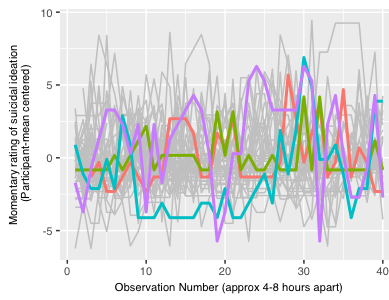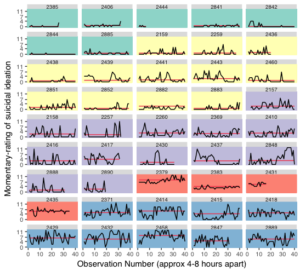Research Methodology
Ecological Momentary Assessment (EMA)
Why do we use EMA?
Much of the research on suicide has measured suicidal ideation and its risk factors with long periods of time (e.g., years, months) between measurements. Although these studies have given us lots of valuable knowledge about suicide, they do not allow us to explore day to day or hour to hour variation in suicidal thoughts and behaviors. We use smartphone-based real-time monitoring to measure suicidal thoughts as they unfold in real-time, and assess the contextual factors associated with suicide risk and resilience as they actually occur.
What have we found using EMA?
We used smartphone monitoring (4x/day over 7-28 days) to study real-time changes in suicidal ideation among two samples of adults at risk for suicidal behavior (suicidal inpatients and recent suicide attempters). These data gave us several interesting insights about suicidal ideation.
First, we found that suicidal ideation varies dramatically throughout the day (see figure to the right). We found across both studies that suicidal ideation ratings varied just as much from observation to observation as they did from person to person.
Second, we found that intense suicidal ideation has relatively rapid onset. We found across both studies that nearly one third of all ratings of suicidal ideation differed by at least one standard deviation from the rating given just a few hours earlier.


Building on the findings that there is substantial variability and heterogeneity in the experience of suicidal thoughts, we sought to see if there was order to this heterogeneity. To do this, we applied to our two real-time monitoring studies a digital phenotyping approach, which refers to analyses (e.g., latent profile analysis, latent cluster analysis) that use multiple indices of data collected from a digital device (e.g., smartphone or wearable device) to identify profiles or phenotypes across people.
Using latent profile analysis (a type of analysis that creates groups or “profiles” of people a based on their responses to a set of variables), we found across both studies five distinct subtypes of suicide ideation (see figure to the left): (1) low mean, low variability (shown in green), (2) low mean, high variability (shown in yellow), (3) moderate mean and variability (purple), (4) high mean, low variability (red), and (5) high mean, high variability (blue). The phenotypes differ primarily in the average severity of suicidal ideation across measurement occasions, and the magnitude of within-person variability around that average. Moreover, the phenotype typified by more severe (i.e., higher mean) and more stable (i.e., lower within-person root mean square of successive differences [RMSSD]) suicidal ideation contained the highest proportion of individuals who had recently attempted suicide.
This is particularly interesting because it might mean that in the time immediately after a suicide attempt, people tend to have persistently high levels of suicidal ideation and as time passes, the mean level of ideation stays high and variability around that mean increases. This would assume that phenotypes are not static, and that people may shift from one phenotype to another in relationship to their environmental context (e.g., time since a suicide attempt, occurrence of life events).
Read more
Kleiman, E.M., Turner, B.J., Fedor, S., Beale, E.E., Huffman, J.C., & Nock, M.K. (2017). Examination of real-time fluctuations in suicidal ideation and its risk factors: Results from two ecological momentary assessment studies. Journal of Abnormal Psychology, 126, 726-738.
Kleiman, E.M., Turner, B.J., Fedor, S., Beale, E.E., Picard, R.W., Huffman, J.C., & Nock, M.K. (2018). Digital phenotyping of suicidal thoughts. Depression and Anxiety, 35, 601-608.
Wearable monitors
Our smartphone-based real-time monitoring work has provided insight into the everyday lives of individuals who are at risk for suicide. Since this work is based on self-report, it has a few limitations such as a reliance on individuals being aware of their affect and cognition and an inability to continuously assess the phenomenon of interest. Thus, it would be valuable to identify objective markers of potential suicide risk that can be assessed passively and continuously. Our work shows that times when people report high levels of suicidal ideation are characterized by high levels of negative emotion (e.g., agitation). Lab-based empirical work finds that negative emotion is associated with certain physiological indicators and recent advances in wearable technology provide a pathway to address these limitations. Accordingly, the second part of our work involves paring smartphone-based real-time monitoring with wearable physiological monitors
Because sweat is a good conductor of electricity, changes in skin conductance, called electrodermal activity (EDA; also called Galvanic Skin Response), signal when an individual is physiologically aroused, possibly because they are experiencing stress. Although not always directly observable, this arousal is present as soon as psychological distress begins to escalate, meaning that these physiological signals of distress may be detectable before high levels of distress escalate to negative outcomes like suicidal ideation. This is important because it could mean that there are ways to identify the highly-distressing period leading up to intense suicidal ideation without having to rely on the suicidal individual to tell us that this is happening.
What are we doing now with wearable monitors?
Much of our work with with wearables is currently ongoing. You can read about our ongoing studies here.
Read more
Kleiman, E.M., Millner, A.J., Joyce, V.W., Nash, C.C., Bunonopane, R.J., & Nock, M.K. (in press). Using Wearable Physiological Monitors With Suicidal Adolescent Inpatients: Feasibility and Acceptability Study. JMIR mHealth and uHealth.
Ecological Momentary Intervention (EMI)
Ecological Momentary Intervention (EMI) refers to using smartphones and related technology (e.g., wearable biosensors) to deliver therapeutic interventions. EMI technology may be particularly useful for suicide risk reduction interventions. The time leading up to and during the experience of suicidal thoughts can be distressing. During a distressing “suicide crisis” it may be difficult for patients to access and use the skills they have learned in therapy. This lack of accessibility during the time when an intervention is most needed may be one reason why existing interventions are not as effective as they could be. Thus, interventions that are accessible and effective during a suicide crisis are needed. EMI is a useful supplement to therapy that can take what is learned in therapy and make it available in the moment it is most needed. In some cases (e.g., for less severe suicide risk), EMI may even be a viable standalone treatment.
What are we doing now with EMI?
Much of our work with with EMI is currently ongoing. You can read about our ongoing studies here.
